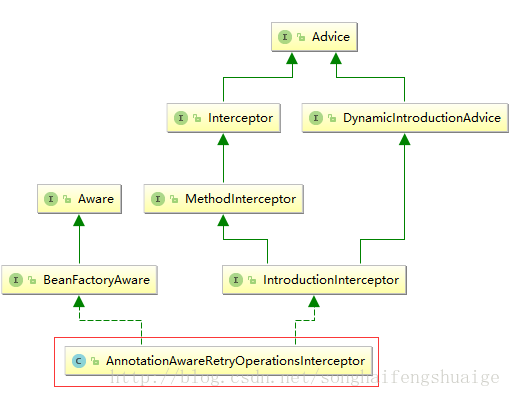Spring-Retry应用
前言
spring retry是从spring batch独立出来的一个能功能,主要实现了重试和熔断。对于重试是有场景限制的,不是什么场景都适合重试,比如参数校验不合法、写操作等(要考虑写是否幂等)都不适合重试。远程调用超时、网络突然中断可以重试。在微服务治理框架中,通常都有自己的重试与超时配置,比如dubbo可以设置retries=1,timeout=500调用失败只重试1次,超过500ms调用仍未返回则调用失败。在spring retry中可以指定需要重试的异常类型,并设置每次重试的间隔以及如果重试失败是继续重试还是熔断(停止重试)。目前在spring cloud中已经渗透到诸多组件,如ribbon等,故本章对原生spring-retry的应用做个简单的梳理和案例分析。
本章概要
1、设计实现原理
2、案例实践:
- 重试策略:SimpleRetryPolicy固定重试次数
- 重试策略:SimpleRetryPolicy固定重试次数
- 重试策略:AlwaysRetryPolicy无限重试
- 重试策略:TimeoutRetryPolicy超时重试
- 重试策略:根据返回结果值实现重试
- 重试策略:启用熔断器重试策略
- 通过RetryListener实现拦截器模式
- 采用注解方式实现
设计实现原理
重试的定义:
RetryOperations定义重试的API,RetryTemplate是API的模板模式实现,实现了重试和熔断。提供的API如下:
RetryCallback定义了需要执行重试的操作,定义好操作后,就是如何重试的问题了。
RetryTemplate通过制定不同的重试策略来执行如何重试的逻辑。默认的重试策略是SimpleRetryPlicy,也就是会重试3次。重试第1次如果成功后面就不会继续重试了。那么如果3尺都重试失败了呢?流程结束或者返回兜底结果。要返回兜底结果需要配置
RecoveyCallBack,从名字可以看出这是一个兜底回调接口,也就是重试失败后执行的逻辑。
重试策略,除了SimpleRetryPolicy还有其他重试策略,先来看下RetryPolicy接口:
方法说明:
- canRetry:在每次重试的时候调用,是否可以继续重试的判断条件
- open:重试开始前调用,会创建一个重试上下文到RetryContext,保存重试的堆栈等信息
- registerThrowable:每次重试异常时调用(有异常会继续重试)
以
SimpleRetryPolicy为例,当重试次数达到3(默认3次)停止重试,重试次数保存在重试上下文中。
所有重试策略实现如下:
- NeverRetryPolicy:只允许调用RetryCallback一次,不允许重试
- AlwaysRetryPolicy:允许无限重试,直到成功,此方式逻辑不当会导致死循环
- SimpleRetryPolicy:固定次数重试策略,默认重试最大次数为3次,RetryTemplate默认使用的策略
- TimeoutRetryPolicy:超时时间重试策略,默认超时时间为1秒,在指定的超时时间内允许重试
- ExceptionClassifierRetryPolicy:设置不同异常的重试策略,类似组合重试策略,区别在于这里只区分不同异常的重试
- CircuitBreakerRetryPolicy:有熔断功能的重试策略,需设置3个参数openTimeout、resetTimeout和delegate
- CompositeRetryPolicy:组合重试策略,有两种组合方式,乐观组合重试策略是指只要有一个策略允许重试即可以,悲观组合重试策略是指只要有一个策略不允许重试即可以,但不管哪种组合方式,组合中的每一个策略都会执行
重试回退(等待)策略,指的是每次重试是立即重试还是等待一段时间后重试。默认情况下是立即重试,如果需要配置等待一段时间后重试则需要指定回退策略
BackOffPolicy。
BackOffPolicy有如下实现:
- NoBackOffPolicy:无退避算法策略,每次重试时立即重试
- FixedBackOffPolicy:固定时间的退避策略,需设置参数sleeper和backOffPeriod,sleeper指定等待策略,默认是Thread.sleep,即线程休眠,backOffPeriod指定休眠时间,默认1秒
- UniformRandomBackOffPolicy:随机时间退避策略,需设置sleeper、minBackOffPeriod和maxBackOffPeriod,该策略在[minBackOffPeriod,maxBackOffPeriod之间取一个随机休眠时间,minBackOffPeriod默认500毫秒,maxBackOffPeriod默认1500毫秒
- ExponentialBackOffPolicy:指数退避策略,需设置参数sleeper、initialInterval、maxInterval和multiplier,initialInterval指定初始休眠时间,默认100毫秒,maxInterval指定最大休眠时间,默认30秒,multiplier指定乘数,即下一次休眠时间为当前休眠时间*multiplier
- ExponentialRandomBackOffPolicy:随机指数退避策略,引入随机乘数可以实现随机乘数回退
有状态重试 OR 无状态重试
所谓无状态重试是指重试在一个线程上下文中完成的重试,反之不在一个线程上下文完成重试的就是有状态重试。之前的SimpleRetryPolicy就属于无状态重试,因为重试是在一个循环中完成的。那么什么会后会出现或者说需要有状态重试呢?通常有两种情况:事务回滚和熔断。
如数据库操作异常DataAccessException,则不能执行重试,而如果抛出其他异常可以重试。
熔断的意思不在当前循环中处理重试,而是全局重试模式(不是线程上下文)。熔断会跳出循环,那么必然会丢失线程上下文的堆栈信息。那么肯定需要一种“全局模式”保存这种信息,目前的实现放在一个cache(map实现的)中,下次从缓存中获取就能继续重试了。
案例实践
场景描述:i作为计数器,如果i小于5则抛出异常,i会进行自增一操作,直到等于5方正常返回,否则根据重试策略进行重试操作,如果直到最后一直未重试成功,则返回Integer最大值。在重试上下文中添加一个value变量,后续通过其值实现根据返回值判断重试应用。最后打印最终的返回值。
示例代码:
private void
run(RetryTemplate retryTemplate)
throws
Exception {
Integer result = retryTemplate.execute(
new
RetryCallback() {
int
i
=
0
;
// 重试操作
@Override
public
Integer doWithRetry(RetryContext retryContext)
throws
Exception {
retryContext.setAttribute(
"value"
,
i
);
LOGGER
.info(
"retry {} times."
, retryContext.getRetryCount());
return
len(
i
++);
}
},
new
RecoveryCallback() {
//兜底回调
@Override
public
Integer recover(RetryContext retryContext)
throws
Exception {
LOGGER
.info(
"after retry {} times, recovery method called!"
, retryContext.getRetryCount());
return
Integer.
MAX_VALUE
;
}
});
LOGGER
.info(
"final result: {}"
, result);
}
private int
len(
int
i)
throws
Exception {
if
(i <
5
)
throw new
Exception(i +
" le 5"
);
return
i;
}
重试策略:SimpleRetryPolicy固定重试次数
示例代码:
@Test
public void
retryFixTimes()
throws
Exception {
RetryTemplate retryTemplate =
new
RetryTemplate();
SimpleRetryPolicy simpleRetryPolicy =
new
SimpleRetryPolicy();
simpleRetryPolicy.setMaxAttempts(
3
);
retryTemplate.setRetryPolicy(simpleRetryPolicy);
run(retryTemplate);
}
打印:
超过3次最大重试次数,触发了recoveryCall,并返回Integer最大值。
重试策略:AlwaysRetryPolicy无限重试
示例代码:
@Test
public void
retryAlwaysTimes()
throws
Exception {
RetryTemplate retryTemplate =
new
RetryTemplate();
retryTemplate.setRetryPolicy(
new
AlwaysRetryPolicy());
run(retryTemplate);
}
打印:
直达i等于5则正常返回,之前将实现无限重试。
重试策略:TimeoutRetryPolicy超时重试
TimeoutRetryPolicy策略定义:重试累计运行时长在设定的timeout范围内则重试,一旦超出则不再重试直接执行RecoveryCallback。
@Test
public void
retryTimeout()
throws
Exception {
RetryTemplate retryTemplate =
new
RetryTemplate();
TimeoutRetryPolicy timeoutRetryPolicy =
new
TimeoutRetryPolicy();
timeoutRetryPolicy.setTimeout(
1000
);
retryTemplate.setRetryPolicy(timeoutRetryPolicy);
FixedBackOffPolicy fixedBackOffPolicy =
new
FixedBackOffPolicy();
fixedBackOffPolicy.setBackOffPeriod(
400
);
retryTemplate.setBackOffPolicy(fixedBackOffPolicy);
run(retryTemplate);
}
打印:
设定1000ms后则认定为超时,每次重试等待时长400ms,故重试3次后即会超出超时阈值,触发RecoveryCallback回调,并返回Integer最大值。
重试策略:根据返回结果值实现重试
@Test
public void
retryWithResult()
throws
Exception {
RetryTemplate retryTemplate =
new
RetryTemplate();
retryTemplate.setRetryPolicy(
new
AlwaysRetryPolicy() {
private static final long
serialVersionUID
=
1213824522266301314L
;
@Override
public boolean
canRetry(RetryContext context) {
//小于1则重试
return
context.getAttribute(
"value"
) ==
null
|| Integer.
parseInt
(context.getAttribute(
"value"
).toString()) <
1
;
}
});
run(retryTemplate);
}
打印:
如果value值小于1或者为null则进行重试,反之不在进行重试,触发RecoveryCallback回调,并返回Integer最大值。
重试策略:启用熔断器重试策略
首先来看
CircuitBreakerRetryPolicy定义
需要设置如下三个参数:
- delegate:传入RetryPolicy(每个RetryPolicy实现都有自己的重试策略实现),是真正判断是否重试的策略,当重试失败时,则执行熔断策略;
- openTimeout:openWindow,配置熔断器电路打开的超时时间,当超过openTimeout之后熔断器电路变成半打开状态(只要有一次重试成功,则闭合电路);
- resetTimeout:timeout,配置重置熔断器重新闭合的超时时间;
断路器判断实现:
可以理解为如下:
- 当重试失败,且在熔断器打开时间窗口[0,openWindow) 内,立即熔断
- 当重试失败,且超过timeout,熔断器电路重新闭合
- 在熔断器半打开状态[openWindow, timeout] 时,只要重试成功则重置上下文,断路器闭合
示例代码:
@Test
public void
retryCircuitBreakerTest() {
RetryTemplate retryTemplate =
new
RetryTemplate();
CircuitBreakerRetryPolicy retryPolicy =
new
CircuitBreakerRetryPolicy(
new
SimpleRetryPolicy(
4
));
FixedBackOffPolicy fixedBackOffPolicy =
new
FixedBackOffPolicy();
fixedBackOffPolicy.setBackOffPeriod(
300
);
retryTemplate.setBackOffPolicy(fixedBackOffPolicy);
retryPolicy.setOpenTimeout(
1500
);
retryPolicy.setResetTimeout(
2000
);
retryTemplate.setRetryPolicy(retryPolicy);
long
startTime = System.
currentTimeMillis
();
IntStream.
range
(
0
,
10
).forEach(index -> {
try
{
Thread.
sleep
(
100
);
RetryState state =
new
DefaultRetryState(
"circuit"
,
false
);
String result =
retryTemplate
.execute(
new
RetryCallback() {
@Override
public
String doWithRetry(RetryContext context)
throws
RuntimeException {
LOGGER
.info(
"retry {} times"
, context.getRetryCount());
if
(System.
currentTimeMillis
() -
startTime
>
1300
&& System.
currentTimeMillis
() -
startTime
<
1500
) {
return
"success"
;
}
throw new
RuntimeException(
"timeout"
);
}
},
new
RecoveryCallback() {
@Override
public
String recover(RetryContext context)
throws
Exception {
return
"default"
;
}
}, state);
LOGGER
.info(
"result: {}"
, result);
}
catch
(Exception e) {
LOGGER
.error(
"error: {}"
, e.getMessage());
}
});
}
打印:
设定重试次数为4次,在执行1300ms至1500ms期间连续两次调用成功,无需重试,其后继续抛出异常重试,第4次重试时(1405)仍然在1500ms内,故打开了断路器,后续请求异常均会直接返回
RecoveryCallback中回调定义。
Note:
- 如果采用无限重试策略则没有意义,将不会触发断路器;
- 必须符合[0,openWindow)时间内重试失败方会发开断路器;
通过RetryListener实现拦截器模式
通过RetryListener实现拦截器模式,默认提供了StatisticsListener实现重试操作统计分析数据,如下示例:
@Test
public void
retryListeners() {
RetryTemplate template =
new
RetryTemplate();
DefaultStatisticsRepository repository =
new
DefaultStatisticsRepository();
StatisticsListener listener =
new
StatisticsListener(repository);
template.setListeners(
new
RetryListener[]{listener});
for
(
int
i =
0
; i <
10
; i++) {
String result = template.execute(
new
RetryCallback() {
@Override
public
String doWithRetry(RetryContext context)
throws
RuntimeException {
context.setAttribute(RetryContext.
NAME
,
"method.key"
);
return
"ok"
;
}
});
}
RetryStatistics statistics = repository.findOne(
"method.key"
);
System.
out
.println(statistics);
}
打印:
采用注解方式实现
以上采用硬编码方式定义实现,整体看起来代码非常的不优雅,Spring已经为我们提供了注解方式,本小节将基于springboot实现一个注解方式案例:
1、通过
@EnableRetry注解启动类:
@SpringBootApplication
@EnableRetry
(proxyTargetClass =
true
)
public class
SpringRetryApp {
}
2、如下通过
@Retryable注解一个待重试方法,并
@Recover注解定义一个对应的Recover方法:
@Component
public class
SpringRetryService {
private static final
Logger
LOGGER
= LoggerFactory.
getLogger
(SpringRetryService.
class
);
@Retryable
(value = Exception.
class
, maxAttempts =
4
, backoff =
@Backoff
(value =
0L
))
public void
run()
throws
Exception {
LOGGER
.info(
"do sth"
);
throw new
Exception(
"error"
);
}
@Recover
private void
recover(Exception e) {
LOGGER
.info(
"invoke recover"
);
}
}
Note:
- Recover方法必须与源方法保持一样的参数列表定义,并添加一个Throwable作为异常信息传递;
3、编写一个测试方法:
@Autowired
private
SpringRetryService
springRetryService
;
@Test
public void
retryWithAnnotation()
throws
Exception {
springRetryService
.run();
}
4、打印:
如上重试4次,并调用了Recover回调返回值。
5、更多的注解说明:
- @EnableRetry
- @Retryable
- @Recover
- @Backoff
- @CircuitBreaker
- @EnableRetry:能否重试,proxyTargetClass属性为true时(默认false),使用CGLIB代理
- @Retryable:注解需要被重试的方法
include 指定处理的异常类。默认为空
exclude指定不需要处理的异常。默认为空
vaue指定要重试的异常。默认为空
maxAttempts 最大重试次数。默认3次
backoff 重试等待策略。默认使用@Backoff注解
- @Backoff:重试回退策略(立即重试还是等待一会再重试)
不设置参数时,默认使用FixedBackOffPolicy,重试等待1000ms
只设置delay()属性时,使用FixedBackOffPolicy,重试等待指定的毫秒数
当设置delay()和maxDealy()属性时,重试等待在这两个值之间均态分布
使用delay(),maxDealy()和multiplier()属性时,使用ExponentialBackOffPolicy
当设置multiplier()属性不等于0时,同时也设置了random()属性时,使用ExponentialRandomBackOffPolicy
- @Recover: 用于方法。用于@Retryable失败时的“兜底”处理方法。 @Recover注释的方法必须要与@Retryable注解的方法“签名”保持一致,第一入参为要重试的异常,其他参数与@Retryable保持一致,返回值也要一样,否则无法执行!
- @CircuitBreaker:用于方法,实现熔断模式。
include 指定处理的异常类。默认为空
exclude指定不需要处理的异常。默认为空
vaue指定要重试的异常。默认为空
maxAttempts 最大重试次数。默认3次
openTimeout 配置熔断器打开的超时时间,默认5s,当超过openTimeout之后熔断器电路变成半打开状态(只要有一次重试成功,则闭合电路)
resetTimeout 配置熔断器重新闭合的超时时间,默认20s,超过这个时间断路器关闭
6、源码浅析:
- @Retryable注解实现源码主要参考AnnotationAwareRetryOperationsInterceptor实现,定义如下:
- @Recover注解实现源码主要参考RecoverAnnotationRecoveryHandler实现,定义如下:
@Retryable和
@Recover注解是如何关联起来的呢,正是上述findClosestMatch和calculateDistance。













